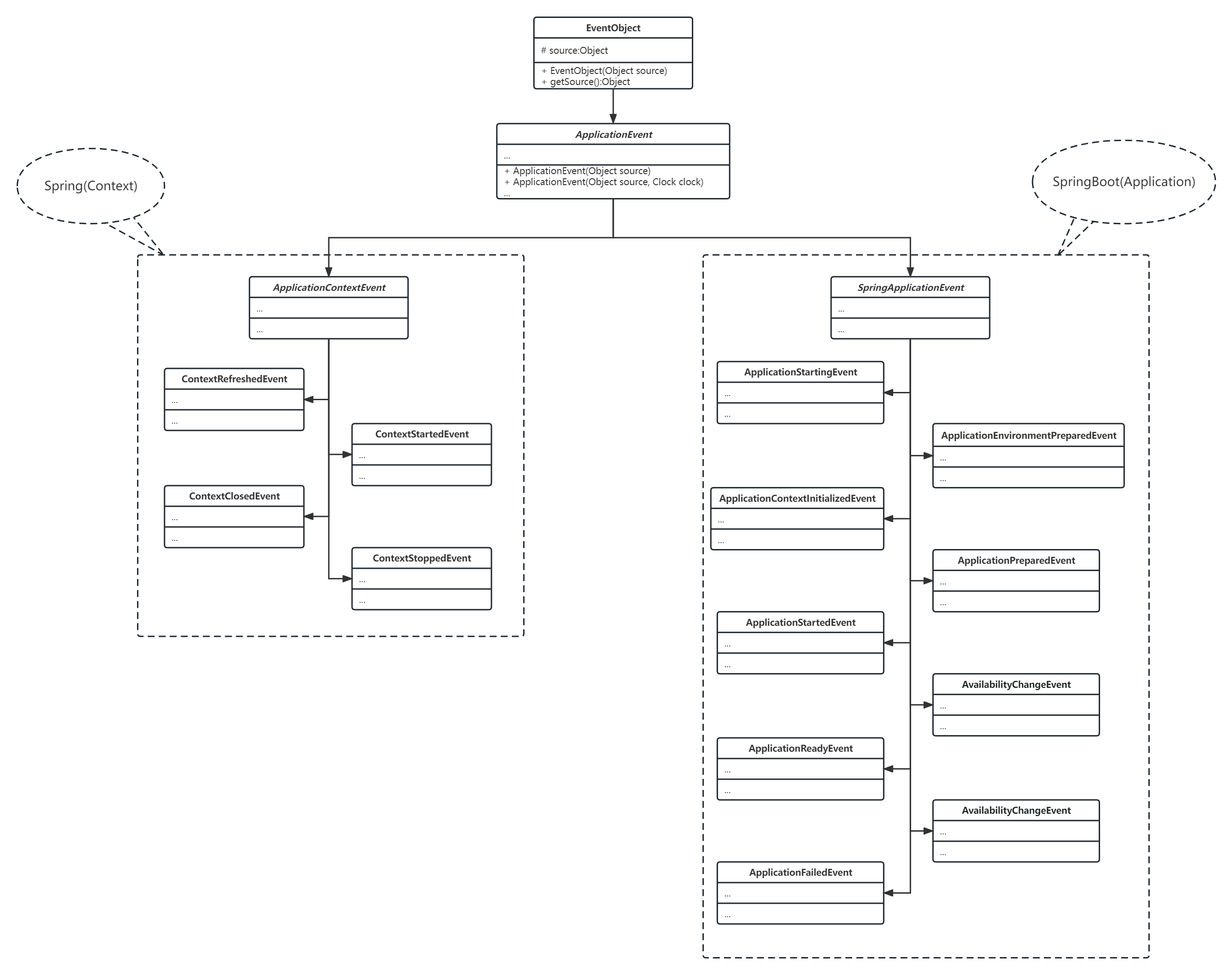从Spring事件的发布顺序说起
最近在解决一个有趣的issue时,利用到了Spring中生命周期事件的发布顺序。主要就是根据不同事件的发布顺序不同,在SpringBoot应用启动的某些阶段触发框架的动态优化逻辑,替换一些bean,并且替换后的bean也能正常监听后续阶段发布的事件并执行替换后的逻辑。
说起这些启动时的生命周期事件,我们都耳熟能详。在研究Spring刷新或者SpringBoot启动流程的源码时都能看到它们的身影,或者也监听过某些事件来实现一些业务逻辑。但是,对于整个的生命周期事件的分类、顺序等的逻辑我其实是一直比较模糊的,需要用到时才会去研究一番。故而,想借此机会来简单梳理一下这些事件,也加深对其背后所代表的应用启动流程原理的了解和理解。
有哪些事件
先来看看Spring(6.0.11)和SpringBoot(3.1.0)中到底有哪些生命周期相关的事件,这里是参照的较新的版本的文档和源码:

- EventObject:顶层父类为
java.util.EventObject,是基于Java的事件机制。 - ApplicationEvent: Spring的顶层抽象类,所有扩展的应用事件类都必须继承它。
接下来就是Spring和SpringBoot的不同实现,从事件名称也可以看出它们的侧重点不一样,也反应了二者(Spring和SpringBoot)的区别:Spring的核心是应用上下文(ApplicationContextEvent),而SpringBoot的侧重点则是应用本身(SpringApplicationEvent)。
先贴一下官方说明文档,再简单做一下说明:
- Spring的事件介绍文档:context-introduction
- SpringBoot的事件介绍文档:application-events-and-listeners
Spring#ContextRefreshedEvent
Published when the
ApplicationContextis initialized or refreshed.
Spring上下文初始化完毕或者刷新完毕,即Environment、BeanFactory、PostProcessor、MessageSource、Listener、Singletons等等都准备完毕之后,会发布此事件。
它也是绝大部分应用走Spring自动加载刷新流程时所关注的核心事件,后面的几个事件都不同于它。
Spring#ContextStartedEvent
Published when the
ApplicationContextis started by using thestart()method on theConfigurableApplicationContextinterface. Here, “started” means that allLifecyclebeans receive an explicit start signal.
文档中明确说明,是在显式的调用ConfigurableApplicationContext#start()方法后上下文启动完成时发布,所以一般我们正常的自动启动流程是监听不到此事件的。
Spring#ContextClosedEvent
Published when the
ApplicationContextis being closed by using theclose()method on theConfigurableApplicationContextinterface or via a JVM shutdown hook. Here, "closed" means that all singleton beans will be destroyed.
同上,对应上下文关闭的事件。
Spring#ContextStoppedEvent
Published when the
ApplicationContextis stopped by using thestop()method on theConfigurableApplicationContextinterface. Here, “stopped” means that allLifecyclebeans receive an explicit stop signal.
同上,对应上下文结束的事件。
SpringBoot#ApplicationStartingEvent
An
ApplicationStartingEventis sent at the start of a run but before any processing, except for the registration of listeners and initializers.
应用启动但未做任何处理(除了一些listener和initializer的注册)时会发送此事件。
SpringBoot#ApplicationEnvironmentPreparedEvent
An
ApplicationEnvironmentPreparedEventis sent when theEnvironmentto be used in the context is known but before the context is created.
环境已经准备完成但上下文还未创建时发送此事件。
SpringBoot#ApplicationContextInitializedEvent
An
ApplicationContextInitializedEventis sent when theApplicationContextis prepared and ApplicationContextInitializers have been called but before any bean definitions are loaded.
在上下文准备完成之后,加载bean definitions之前发送此事件。
SpringBoot#ApplicationPreparedEvent
An
ApplicationPreparedEventis sent just before the refresh is started but after bean definitions have been loaded.
在上下文准备完成且加载bean definitions完成之后,刷新上下文之前发送此事件。
SpringBoot#ApplicationStartedEvent
An
ApplicationStartedEventis sent after the context has been refreshed but before any application and command-line runners have been called.
在上下文刷新完成之后,调用ApplicationRunner和CommandLineRunner之前发送此事件。
SpringBoot#AvailabilityChangeEvent
An
AvailabilityChangeEventis sent right after withLivenessState.CORRECTto indicate that the application is considered as live.
在Runner调用完毕后立即发送,表示当前应用已处于活动状态:LivenessState.CORRECT。
SpringBoot#ApplicationReadyEvent
An
ApplicationReadyEventis sent after any application and command-line runners have been called.
在Runner调用完毕后发送,表示应用已经准备完毕。
SpringBoot#AvailabilityChangeEvent
An
AvailabilityChangeEventis sent right after withReadinessState.ACCEPTING_TRAFFICto indicate that the application is ready to service requests.
应用准备完毕后,还会发送一次此事件,表示当前应用已经可以接收请求了:ReadinessState.ACCEPTING_TRAFFIC。
SpringBoot#ApplicationFailedEvent
An
ApplicationFailedEventis sent if there is an exception on startup.
启动过程中出现异常时,会发送此事件。
从源码来看
在梳理完上面的这些事件后,其实基本上对Spring和SpringBoot启动流程中一些重要的节点有了初步的印象。那现在就直接从源码来看,会更加清晰。
AbstractApplicationContext#refresh
Spring启动刷新上下文的核心方法,都很熟悉。步骤分明,注释清晰,优雅的代码:
public void refresh() throws BeansException, IllegalStateException {
synchronized (this.startupShutdownMonitor) {
StartupStep contextRefresh = this.applicationStartup.start("spring.context.refresh");
// Prepare this context for refreshing.
// 记录刷新开始时间、初始化PropertySources、记录刷新之前注册的监听器(如果有)
prepareRefresh();
// Tell the subclass to refresh the internal bean factory.
// 获取实例化的BeanFactory。默认的实现是 DefaultListableBeanFactory
ConfigurableListableBeanFactory beanFactory = obtainFreshBeanFactory();
// Prepare the bean factory for use in this context.
// 向BeanFactory中填充属性/配置/组件等等
// 如ClassLoader、某些post-processors、bean的表达式解析器(StandardBeanExpressionResolver)、environment beans
prepareBeanFactory(beanFactory);
try {
// Allows post-processing of the bean factory in context subclasses.
// BeanFactory初始化完成后,执行一些固定的后置处理。
// 这里用最常见的Web应用来说明:
// Web应用在此处会向BeanFactory中添加一些Servlet相关类的依赖解析,以便于处理它们的自动注入。
// 因为像ServletRequest和HttpSession是动态变化的,并不是单例bean,这里Spring是利用ObjectFactory来实现的
// 也就是说实际上注入的ServletRequest是一个对象工厂,每次取HttpServletRequest时是调用的此ObjectFactory来从请求上下文取值
postProcessBeanFactory(beanFactory);
StartupStep beanPostProcess = this.applicationStartup.start("spring.context.beans.post-process");
// Invoke factory processors registered as beans in the context.
// 执行为BeanFactory准备的后置处理器
invokeBeanFactoryPostProcessors(beanFactory);
// Register bean processors that intercept bean creation.
// 注册为bean准备的后置处理器
registerBeanPostProcessors(beanFactory);
beanPostProcess.end();
// Initialize message source for this context.
// 初始化MessageSource,国际化的标准实现就是利用MessageSource,还有就是像javax Validation的自定义消息也可以用它实现
initMessageSource();
// Initialize event multicaster for this context.
// 初始化事件多播器,默认SimpleApplicationEventMulticaster
initApplicationEventMulticaster();
// Initialize other special beans in specific context subclasses.
// 默认空,子类重写,初始化子context独有的类
// SpringBoot中的ServletWebServerApplicationContext就会重写它,用来初始化内置的Tomcat或其它WebServer
onRefresh();
// Check for listener beans and register them.
// 把事件监听器注册到EventMulticaster中去,且在此时会发布在EventMulticaster初始化之前的事件
registerListeners();
// Instantiate all remaining (non-lazy-init) singletons.
// 主要是初始化我们通常所说的单例bean
finishBeanFactoryInitialization(beanFactory);
// Last step: publish corresponding event.
// 最后结束的时候发布了ContextRefreshedEvent事件
finishRefresh();
}
catch (BeansException ex) {
if (logger.isWarnEnabled()) {
logger.warn("Exception encountered during context initialization - " +
"cancelling refresh attempt: " + ex);
}
// Destroy already created singletons to avoid dangling resources.
// 销毁单例bean,移除内存中的单例bean并回调bean的`destroy()`方法
destroyBeans();
// Reset 'active' flag.
cancelRefresh(ex);
// Propagate exception to caller.
throw ex;
}
finally {
// Reset common introspection caches in Spring's core, since we
// might not ever need metadata for singleton beans anymore...
resetCommonCaches();
contextRefresh.end();
}
}
}
...
protected void finishRefresh() {
// Clear context-level resource caches (such as ASM metadata from scanning).
clearResourceCaches();
// Initialize lifecycle processor for this context.
initLifecycleProcessor();
// Propagate refresh to lifecycle processor first.
// 在初始化上面的LifecycleProcessor后,走的逻辑跟显式调用`start`方法的逻辑一样。当然start的bean就不一定一样了,且不会发布任何事件
getLifecycleProcessor().onRefresh();
// Publish the final event.
publishEvent(new ContextRefreshedEvent(this));
}AbstractApplicationContext#start
显式调用的start()和stop()方法,可以看到会发布ContextStartedEvent和ContextStoppedEvent:
@Override
public void start() {
getLifecycleProcessor().start();
publishEvent(new ContextStartedEvent(this));
}
@Override
public void stop() {
getLifecycleProcessor().stop();
publishEvent(new ContextStoppedEvent(this));
}SpringApplication#run
SpringBoot的应用启动核心流程如下:
public ConfigurableApplicationContext run(String... args) {
long startTime = System.nanoTime();
// 创建一个BootstrapContext:引导上下文,在ApplicationContext真正刷新完成前可用
DefaultBootstrapContext bootstrapContext = createBootstrapContext();
ConfigurableApplicationContext context = null;
// 声明当前应用使用headless模式:表示应用处于服务器模式下,无法调用外接设备,如显示器、鼠标等,主要是针对awt的使用场景。
// SpringBoot当然默认是非交互式、非可视化的服务器应用
configureHeadlessProperty();
// 注册SpringApplicationRunListener
// 加载应用本身的监听器(主要是EventPublishingRunListener,生命周期相关的事件由它来发布)
// 以及一些扩展的hookListener,用于自定义监听某些启动阶段
SpringApplicationRunListeners listeners = getRunListeners(args);
// 发布 ApplicationStartingEvent
listeners.starting(bootstrapContext, this.mainApplicationClass);
try {
ApplicationArguments applicationArguments = new DefaultApplicationArguments(args);
// environment的加载准备,会发布 ApplicationEnvironmentPreparedEvent
ConfigurableEnvironment environment = prepareEnvironment(listeners, bootstrapContext, applicationArguments);
// 打印banner信息
Banner printedBanner = printBanner(environment);
// 根据当前应用类型(Servlet、Reactive)创建一个 ConfigurableApplicationContext
context = createApplicationContext();
context.setApplicationStartup(this.applicationStartup);
// 刷新应用上下文前的准备工作:
// 1.注册environment(避免重复加载)、应用上下文的后置处理、执行应用上下文刷新前的initializer
// 2.发布 ApplicationContextInitializedEvent
// 3.关闭BootstrapContext:这里会发布一个BootstrapContextClosedEvent,监听它能拿到BootstrapContext和ApplicationContext。如果需要做一些bean的迁移可以在此处实现
// 4.向BeanFactory中添加一些配置属性,往ApplicationContext中添加一些BeanFactory的后置处理
// 5.核心步骤,加载BeanDefinition
// 6.加载完毕后,发布 ApplicationPreparedEvent
prepareContext(bootstrapContext, context, environment, listeners, applicationArguments, printedBanner);
// 调用Spring的`AbstractApplicationContext#refresh()`方法,刷新上下文
refreshContext(context);
// 默认空实现,预留的钩子
afterRefresh(context, applicationArguments);
Duration timeTakenToStartup = Duration.ofNanos(System.nanoTime() - startTime);
if (this.logStartupInfo) {
new StartupInfoLogger(this.mainApplicationClass).logStarted(getApplicationLog(), timeTakenToStartup);
}
// 发布 ApplicationStartedEvent和AvailabilityChangeEvent(LivenessState.CORRECT)
listeners.started(context, timeTakenToStartup);
// 调用ApplicationRunner和CommandLineRunner的实现
// 譬如seata-server的启动就是一个SpringBoot应用,实现了CommandLineRunner来触发调用Server.start
callRunners(context, applicationArguments);
}
catch (Throwable ex) {
if (ex instanceof AbandonedRunException) {
throw ex;
}
// 失败后会发布 ApplicationFailedEvent
handleRunFailure(context, ex, listeners);
throw new IllegalStateException(ex);
}
try {
if (context.isRunning()) {
Duration timeTakenToReady = Duration.ofNanos(System.nanoTime() - startTime);
// 发布 AvailabilityChangeEvent(ReadinessState.ACCEPTING_TRAFFIC)
listeners.ready(context, timeTakenToReady);
}
}
catch (Throwable ex) {
if (ex instanceof AbandonedRunException) {
throw ex;
}
// 失败后会发布 ApplicationFailedEvent
handleRunFailure(context, ex, null);
throw new IllegalStateException(ex);
}
return context;
}
...
private DefaultBootstrapContext createBootstrapContext() {
// SpringBoot中的另一个IOC容器,在刷新应用容器之前,可以通过它来创建一些组件实例,通过BootstrapRegistryInitializer接口来实现
// 譬如说SpringCloud的ConfigServer会在此时注册一些组件
DefaultBootstrapContext bootstrapContext = new DefaultBootstrapContext();
this.bootstrapRegistryInitializers.forEach((initializer) -> initializer.initialize(bootstrapContext));
return bootstrapContext;
}小结
在整理完事件顺序和阅读完源码之后,Spring及SpringBoot的启动流程就一目了然了。流程的各个关键阶段都发布了对应的事件来方便做监听和扩展。而且在梳理整个流程的过程中,也会发现一些其它很优秀、很巧妙的设计,比如:
- 钩子函数:如AbstractApplicationContext#onRefresh、SpringApplication#afterRefresh
- 对象工厂:ObjectFactory替代实际的单例bean,再真正需要的时候从工厂灵活获取真实的bean对象
- BeanPostProcessor:后置处理器接口,Spring实现AOP的经典设计
- PropertySource:应用的键值配置都转换成了这个抽象类。还可以基于它做自定义组件的属性源,如NacosPropertySource
- SpEL:强大的Spring表达式语言。之前也基于它实现过一个操作日志组件
除了Spring和SpringBoot本身之外,在SpringCloud以及各家大厂的不同版本中,也有一些常见事件,比如SpringCloud#RefreshEvent、SpringCloud#EnvironmentChangeEvent、SpringCloud#RefreshScopeRefreshedEvent,在使用SpringCloud标准的@RefreshScope实现远程配置动态刷新时相关的几个事件。